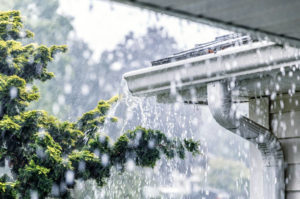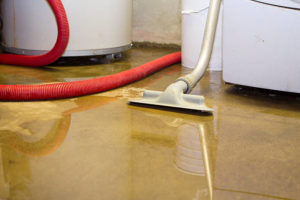What Should I Do If My House Floods?
Recently, a client of AMD Environmental called our team for support when he learned his finished basement flooded after a storm. He walked into his house to find boxes, toys, laundry baskets, and papers floating in murky water in the basement. He surveyed the damage from the basement steps, conscious of the risk of electrocution from electrical outlets or cords.
From a distance, he could tell that the walls were soaked. He wondered if the wallboards would need to be removed and if this was a job he could do himself. As he continued to scan the room, more problems became evident. The furniture was soaked and would most likely go in the trash. Some of the children’s toys were submerged under water while other toys floated by the staircase. He was sure there would be numerous issues to deal with once the water subsided, but he had no idea what to do first.
Our client quickly realized one thing. He was not prepared for a flood.
The first phone call he made was to our team at AMD Environmental to assess the water damage and identify hazardous risk factors that could potentially cause harm. An experienced professional guided him through the clean up process step by step and the flooding was under control within 12 hours. He learned some lessons throughout the process and is now better prepared for a flood.
What should I do if my home floods?
If you, like our client, ever return home to a flooded basement, there’s a few things you will need to figure out before you start the clean up process.

First, find out where the water came from. This will determine how you tackle the clean up job and the type of equipment you’ll need. If outside water seeps into the basement, it’s likely to contain pathogens or other organisms. Because of this, you may need to wear protective equipment to avoid contact with the water.
Rubber boots are especially important to wear while surveying the flooded space and it is highly advised to disconnect the electrical units.
If the flooding is not caused by an act of nature, it might just be that a pipe burst and water is pouring down the walls into other parts of your home. In this case, turn off the main water valve to get the flooding under control. Rubber boots are still necessary to wear in the water, however, the risk of infectious organisms is not as high.
Kick it into high gear once you know the source of the water. You’ll need to act quickly in an effort to minimize loss and salvage as much as possible.
Here’s 6 immediate steps to take if your house floods:
1. Get the water out!
The very first step to controlling the damage is to get the water out of your house. The faster you can mitigate the water damage, the better off you will be.
There are a few ways you can get rid of the standing water in your house:
- Wet/Dry Vacuum
A wet/dry vacuum is a common household item that can be purchased at most hardware stores. This handy appliance uses powerful suction to remove water.
 Each vacuum varies in storage capacity so choose wisely.
Each vacuum varies in storage capacity so choose wisely.
- Submersible Utility Pump
A submersible utility pump is a fairly inexpensive purchase when compared to the potential cost of flood damages. This type of pump moves up to 1,800 gallons of water per hour. If you can’t get a restoration company out to your house within 48 hours, you can remove the water yourself with this household appliance.
- Sump Pump
Unfortunately, if the water seeping into your house is a result of heavy rains, you’ll need to wait until the rain event is over before you clean up. Your sump pump SHOULD pump water away from your house in an effort to keep the basement dry. Just be ready to rock and roll with the clean up efforts when the rain ceases.
No matter which type of equipment you use, the drainage method is important and should work to get all the water out of the house within 48 hours.
2. Remove Damaged Materials
This is when the real fun begins. You must clear out as much as you can from the flooded space. This includes tearing out carpets, removing baseboards, furniture, cardboard boxes, and anything else that is soaked from the flood. Air out as much as you can outside of the house or in the garage.
When asked about removing flood items, Anthony DeMigilio of AMD Environmental says, “it’s important to remove as much as possible to reduce the humidity and water vapor in the flooded space.” He went on to say that, “the walls and carpeting can discharge moisture, so clearing out and drying out is the key to reducing the potential for mold to grow.”
One special consideration before you remove damaged materials is to know exactly what you are dealing with. For example, if an older home contains asbestos or lead containing materials, you will want a company to test for asbestos or lead right away. Then, the hazardous materials need to be carefully removed.
3. Start Drying Immediately
Once you clear out the affected contents, start drying the flooded space immediately. Use as many fans as possible. Set the fans at a 45 degree angle and create a cyclone in the room. You can also use dehumidifier units in the center of the cyclone to capture the moisture.
Use a hygrometer (an instrument that measures the amount of water vapor in the air) to maintain the relative humidity at or below 60%.
While you are fanning the space, cut out parts of the drywall (if applicable) to allow for better airflow behind walls.
If you don’t start drying immediately, the walls will absorb moisture which will evaporate with no place to go. With no place to go, the moisture will reabsorb itself in other areas of the house. This will increase the likelihood of mold growth which is the opposite of what we want to happen.
4. Clean and Sanitize

Cleaning is an important part of mold prevention. After all of the water is removed and the soaked contents of the basement are outside drying, it’s time to sanitize.
Before you clean the basement (assuming you are the one doing the cleaning), make sure you maintain proper safety measures. Continue to wear rubber gloves and boots, protective eye-wear, and a face mask.
Use detergents, soap and water, or make a bleach solution with 1 cup bleach per gallon of water in order to prevent mold from growing within 48 hours.
Here’s a few things to keep in mind:
- Do NOT mix ammonia and bleach together
- For hard surfaces, household disinfectants will work just as well as the bleach and water combination
- If you wash clothes and blankets, be sure to use a mixture of bleach and detergent
- Do not try to salvage items like pillows, fabric coverings, stuffed animals, paper products, or cushions
- Throw away items that cannot be properly sanitized
5. Contact Your Insurance Company
One of the biggest mistakes you can make as a homeowner is failing to secure flood insurance. Most people don’t even know if they have flood insurance which causes more stress in a flood situation.

But let’s say you do have flood insurance, make the call right away. Take pictures as soon as you get the water out or when you have at least started the water mitigation process. Document as much as you can in videos or photos to capture the damage to your property and loss of belongings.
Ask your insurance company representative if it’s necessary for an adjuster to come out to your home or if your pictures and videos are sufficient for a claim.
6. Call A Pro
Some jobs are better left to experienced professionals who can guide you through a restoration process. The experts at AMD Environmental have extensive experience advising homeowners in situations where water damage could turn into a potential health problem.
 The AMD team will evaluate the extent of the damage, help you determine what is salvageable, and advise on the type of equipment needed to aid in your clean up efforts.
The AMD team will evaluate the extent of the damage, help you determine what is salvageable, and advise on the type of equipment needed to aid in your clean up efforts.
Have A Flood Plan Ready
Most people do not have a flood plan. But they should!
Here are a few tips to get you started with a plan:
- Check your sump pump regularly (this is more preventative)
- Purchase an inexpensive moisture alarm
- Create a pathway if you tend to store a lot of items in your basement
- Purchase an insurance rider to cover flood damage (riders are amendments to your insurance and typically only add a nominal amount of money to your policy)
- Store valuable items as high up as possible
For more information about mold and how to prevent mold growth, visit AMD Environmental’s website. We are here for you.

